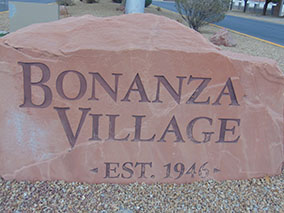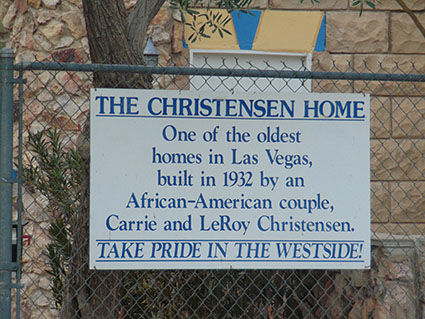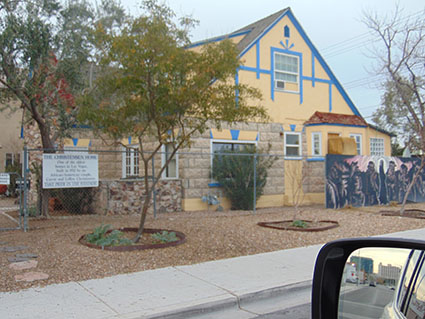Oral History: Barbara Kirkland
February 8, 2016 by Las Vegas Black Image Magazine
Filed under Conversation
‘Those Were Exciting Times!’
Barbara Kirkland first arrived to Las Vegas in 1946, coming from Shreveport, Louisiana, with her mother. In honor of Black History Month, the renowned educator — who once taught at the Historic Westside School and Kit Carson Elementary School — recently sat down to share her recollections about the Historic Westside Community and the places that African-Americans frequented in Las Vegas during the 1940s, 1950s, and 1960s.
The year was 1946 and I was 12 years of age when my mother, Atha Tolliver, and I first arrived here in Las Vegas. My mother had come to Las Vegas on the encouragement of friends — and for the prospect of earning better wages working as a maid. Initially, we lived downtown where many African-Americans lived and owned property, next to what is now the Mob Museum.
This was before African Americans were restricted to the Historic Westside area. African- Americans living in Henderson, in the 1940s, resided in Carver Park. This area was designed to house African-Americans who came to Las Vegas from the Deep South to work at the Basic Magnesium Plant. But, the downtown area is where many other African- Americans lived and owned property.
Contrary to what we hear, the entire Historic Westside area was not shacks and a shanty community with cardboard roofs. It wasn’t like that when we arrived.
A pioneer of African-American descent, Lucretia Tanner Christensen Stevens, owned property and a hotel downtown. Ultimately, she along with other black property owners sold their properties and homes to make way for Downtown expansions and development.
During that time, we rented from a lady who had a house on her property. It wasn’t long before found a bigger house for rent, close to the New Jerusalem Baptist Church on D Street.
I can remember Mr. Spats, an African- American businessman who owned the neighborhood grocery store that was located where the New Jerusalem Fellowship Hall stood as well as a few apartment buildings on Washington. They are long since vacant.
We were living on Van Buren Avenue when my mother started to get disillusioned with Las Vegas. Shortly after, we moved back to Shreveport, where I finished high school. Once again, the appeal of higher wages and a better life brought my mother back to Las Vegas and I rejoined her after I graduated from Southern University in 1955. We lived at the Cadillac Arms–luxury apartments in the Historic Westside Community. These apartments were situated directly across from the first housing community, Berkley Square. Dancers and performers from the Historic Moulin Rouge Hotel’s show stayed in the homes in Berkley Square Housing development in 1955.
Then came the development of Bonanza Village, a housing area not a part of the Historic Westside community because it was one block over from what is now Martin Luther King. Bonanza Village was exclusively for white residents, and therefore off-limits to African Americans. There was a Bonanza Village code — and when that code was broken by a resident who sold their home to an African-American, white people moved out of their homes in vast numbers.
Years later, the influx of prominent people — such as Dr.Charles West [first black licensed doctor in Nevada] and his wife Dottie; Charles Kellar [first black attorney in Nevada]; Judge Robert Reid [first black judge in Nevada] and his wife Sandra; and Bob Bailey [television producer and host; businessman, Equal Rights Commissioner, and first U.S. Presidential appointee from Nevada] and his wife, Anna — moving into Bonanza Village began the process of desegregating the once all-white community.
Certain areas of the Historic Westside were divided by economic class. People who were more financially sound were able to live wherever they wanted within the Historic Westside community. And there were two project areas back then in the Historic Westside. One was called Marble Manor and the other was by Matt Kelly Elementary School. Today, more than 50 years later, the place still stands and is home to a new generation of residents.
Everyone in the Historic Westside community really knew each other. Prior to 1955, in the early days we would all socialize together in our homes or at church activities. The hotels weren’t welcoming African- Americans in their properties at this time, so we all entertained ourselves with house parties. I would tease and say, “We can take a black census any time.”
My husband, Donald Kirkland, was also an educator and we really had a great time. Jackson Avenue in the Historic Westside community, was a popular place to go if you black-owned businesses attracted the likes of popular celebrities, such as Sammy Davis Jr., who could be seen at the various hotel and casino hot spots. Those were exciting times!
Lubertha Johnson’s [first black nurse in Nevada] parents owned property in Henderson called The Warden Ranch. It was beautiful and peaceful — like an oasis with trees and green grass. We would all go there and picnic. For a lot of us, it provided a momentary escape from the commotion of the city. Warden Ranch in Henderson was located by what is now McCarran Airport.
Back when the Vegas View mobile home area in the Historic Westside community only accommodated white people, many of the residents had aspirations to move out.
I recall one time my husband and I filled out an application to buy a new home. While we eagerly watched the construction of our home, we would routinely ask the developer about the status of our application. We were told, “Everything is going fine.” But, to our surprise after the home was built they said we weren’t approved. Later we found out that our housing application was never given to a lending institution in the first place. We learned a valuable lesson from that experience.
Most African-Americans who wanted to own their own homes, either in the Historic Westside community or anywhere else in Las Vegas, had to save their cash and build their own home without assistance from a home lending institution. And that’s how we did it.
Many have asked why I still reside in my West Las Vegas home today and I say, “I know my neighbors and I will never go hungry. I feel safe in my neighborhood, contrary to the belief that there is a lot of crime. I have lived here for many years and haven’t witnessed one incident of crime in my neighborhood. We really look out for one another.”








